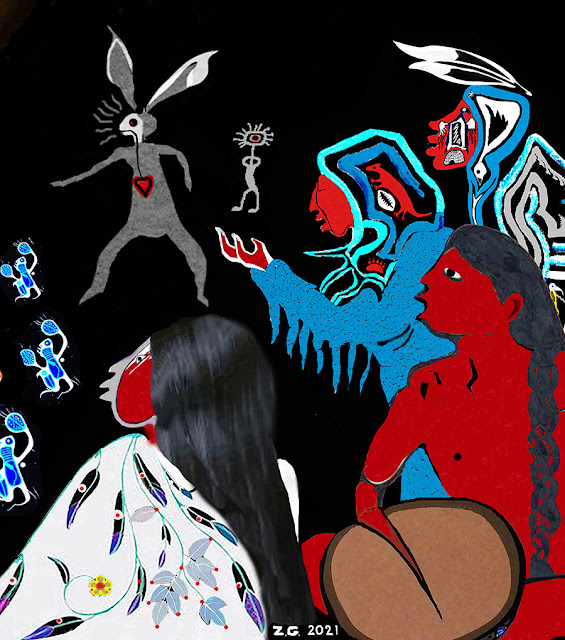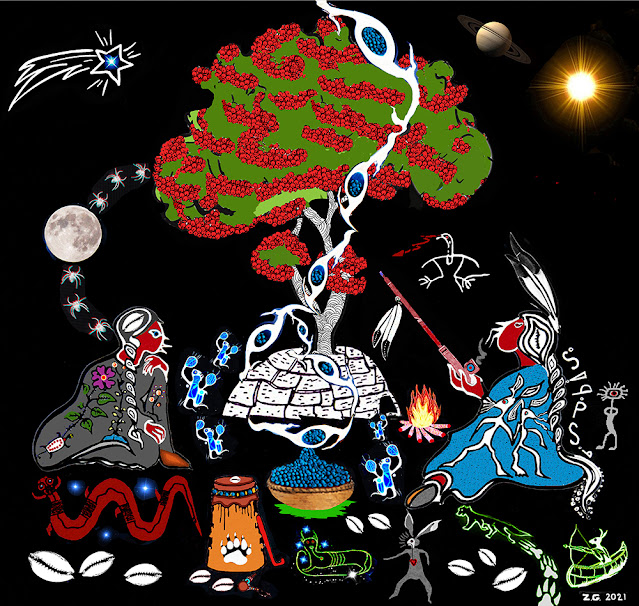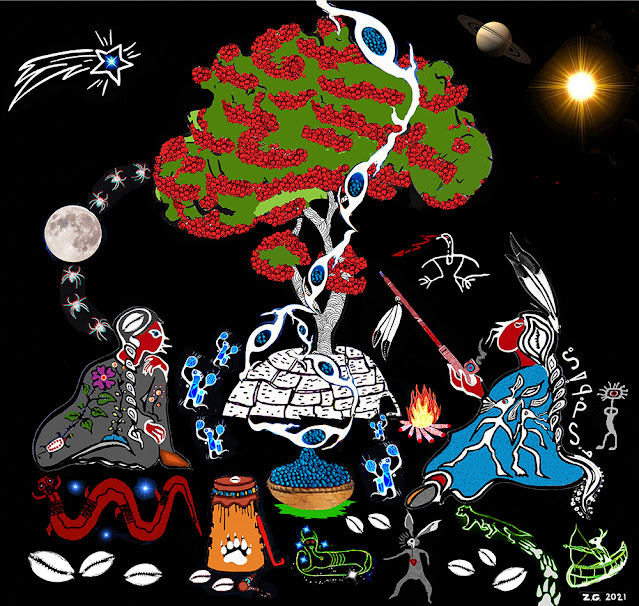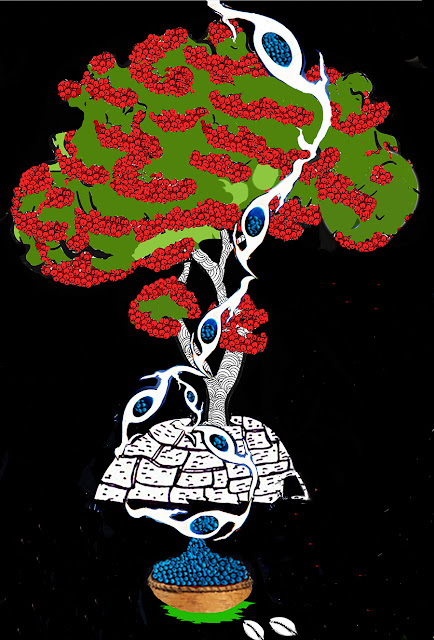Debaajimod and the Story Tree
____________________________________________________
INTRODUCTION
Boozhoo, aaniin! Ever since my distant Ojibwe Anishinaabe ancestors could first communicate, they have gathered to share stories. From then on they - particularly the
Elders - used to pass on traditional tales to the young generation.… the
content of these dramatic, often humoristic, narratives usually referred to
animals, trees, plants, celestial bodies, and the spirits. The stories were not
just a form of entertainment, but also powerful tools, valuable lessons containing
a vast wealth of knowledge and wisdom, since time immemorial passed on to the
next generation.
The stories not
only contained lessons but were also mirrors
reflecting the beliefs, fears, and hopes of both storyteller and audience. Many
stories were sacred and considered to be manidoog (“spirits”) in themselves, filled
with mystery and healing powers. Storytelling usually took place at family and
community gatherings and were told in a strict ritual context and only in the
evenings during the cold moons, when the terrestrial animals
and the humans hide from biboon's icy breath in their snowed-in dens and caves
and houses. The reason for
this was twofold. During the other seasons people were too busy
growing, gathering, and hunting food and spending time in ceremony, and, so as not
to avoid offending the Underwater manidoog – who slept during the winter moons
- it was deemed unwise to talk about them while
they were awake.
Reading my blogs, of course, is not really a traditional way of learning; for that matter I consider myself a modern, not a traditional, storyteller. Since many youngsters nowadays don’t live in a traditional setting and have no Elders around to learn from and tell stories, I choose – as respectfully as I can – to impart through my art – graphic works, jewelry, and writings – the ancestral traditions in a contemporary, perhaps even unorthodox fashion. This means that through my graphic art and jewelry, the traditional context is being redefined into a relatively new tradition (called Woodland Art by many). By the same token, however, I consider the age-old, conventional and very sacred context of storytelling still to be there in my work; the way I see it, the ritual and consecrated aspects of storytelling are, in my artist’s conscience, an inherent part of the creative process.
The following, partly traditional and partly fictional, story will shed some light on the nature of Anishinaabe dadibaajimowin (Ojibwe storytelling) as it has been known throughout the ages. Please note that, although the teachings and opinions of our traditional Elders are taken into respectful consideration, my storytelling is always a mixture of tradition and my own imagination and merely reflects my personal views and dreams. After all, I am an artist-storyteller and certainly do not speak with the knowledge, let alone authority, of a Midewiwin-teacher.
PART 1: DEBAAJIMOD (THE STORYTELLER)
Today’s story will be about an Anishinaabe inini
(Ojibwe man) who actually existed a long time ago, and with whom I feel great
kinship. In my narrative, he, although born an Anishinaabe, was raised in a far-away country and
only occasionally visited his People. The great Anishinaabe art of storytelling
can be traced back to this extraordinary
man, who was both loved and maligned in his time and who nowadays is credited
for having been the first person in history who raised the spoken word to an
art form.
Debaajimod – for that was his name – is said to have been
a frequent winter evening visitor at the lodge of Nookomis, somewhere on the
southern shore of Gichigami, the great freshwater sea nowadays called Lake Superior. She
was man’s first mother and the grandmother of Wenabozho, the beloved
spirit-friend of the Anishinaabeg people.
The reason for Nookomis’ hospitality was undoubtedly Debaajimod’s unequaled skills in telling stories. Debaajimod, because of his incredible storytelling techniques, could not only hold an audience hang on his lips for an evening, two evenings – yes, even for the entire ᐱᐴᓐ᙮ biboon, or winter season; he actually made up new stories that had never been told before! Because of this the public loved him!
But no matter how popular Debaajimod was with his People, it’s not an exaggeration to say that Nookomis was Debaajimod’s biggest fan. When her guest told stories she would hang on every word he spoke. She particularly loved him since he had developed an endless array of rhetorical devices such as metaphors and metonymies to bring alive his narratives. This in itself was not new – teaching through metaphor and allegory has always been the Anishinaabe way – but Debaajimod introduced a new way of storytelling, in the form of, what today would be called, frame stories: a story within a story. Which means his narratives consisted of a mixture of several different aawechiganan (parables, often with a moral undertone) and aadizookaanan, (metaphoric narratives of a traditional, sacred nature), integrated in the larger story. - called "true story." More or less like the story you are reading right now!
During long winter nights Debaajimod would sit in Nookomis’ wiigiwaam (lodge) and tell stories. Every night, after he smoked his opwaagan (pipe), he told another heart-stirring tale of human and celestial connections, a magic teaching parable, or a "true story," sometimes based on his own life or on historical events; other times he opened up before her fantastic adventures about the many spirits and semi-spirits that live in remote and enchanted places. There were narratives about a man’s quest of love, about courage and determination, about overcoming obstacles and about purity of heart, and there were fantastic stories about how Wenabozho and other hero-spirits conquered the beings of the Underworld and the Sky World, and of course there were humoristic stories about Nookomis’ favorite story figures: the Little People of the forest. Each story contained a, sometimes black-humor riddled, metaphorical lesson about the need for the virtues of resourcefulness, perseverance, and fortitude…There were so many valuable lessons in his stories! Every night there would be a new story and she loved every word of it!
 |
| Debaajimod telling Wenabozho Stories |
PART 3: GIIGIDOWIN (THE CONVERSATION)
When one evening Debaajimod asked Nookomis why her grandson Wenabozho - pretty much of a fantasist and a braggart himself, and who happened to be the central protagonist in many of Debaajimod's narratives – had stopped coming by to pay his grandmother visits, she told him – somewhat embarrassed – that he was jealous of Debaajimod. “Atayaa! Debaajimod has eaten too many nibwaakaaminensan (smart berries) for his own good! He is nothing but a mayagwewinin, mamaandaagowinin and gemoodishkid, a foreigner, a toffee-nosed swank-pot, and a thief who is not even part of our community yet pretends to know everything, and I don’t care to see him,” he once had told her. (Needless to say that the often humorous way Debaajimood pictured him in the stories offended Wenabozho’s rather vain disposition!)
Now, see, this was Debaajimod’s tragedy. He didn’t just know a lot; he knew too much. His omniscience and wisdom had become the root of the envy and hatred the famous people and spirits that approached to listen in at his storytelling had started to feel for him. As he had become a popular guest at festivals and meetings where Anishinaabeg gathered to wed, sing and dance, his storytelling became so popular with the general public that it even pushed the singing and dancing to the background! This of course particularly angered Wenabozho and his sibling Papiigawiz, patron of wind and dance, and Jiibayaabooz, patron of music and songs, who noticed the people no longer visited the festivals and feasts to honor them but instead to listen to Debaajimood’s fantastic stories…
But Nookomis, who was very wise and knew people and
was well aware of the seed of jealousy that is so often sown in the hearts and
minds of those with a poor self-image, looked at her visitor in a different light. She simply
loved his stories! She encouraged him not to give up, but also warned him by
saying: “In order to gain credibility – and, more importantly, keep
your credibility - you’d better make
sure not to show to everyone you know everything, noozis (grandson). Self-awareness
is so often mistaken for cockiness by those who have both status and a low
self-esteem. Do not give them a reason to envy or hate you. It’s better to be
modest and keep a low profile!”
“But how am I supposed to do both, nooko?” Debaajimod asked her. How can I keep telling stories and at the same time constrict myself in doing so? I cannot possibly tell stories half-heartedly?” Nookomis, who besides very wise was also pretty sly, chuckled and told her visitor, “Geget! This is why you must only visit me and entertain me, and only me, with your aadizookanan!
When she was done chuckling Nookomis put on her usual straight face, and she asked Debaajimod, “But tell me, noozis, how are stories born?” Debaajimod thought a while and – being a born storyteller and therefore somewhat verbose and not always to the point – said, “Aahaw! I will tell you this, nooko. Each story is a tree person who lives in the land of the Great Story Nation. This nation is larger than any other nation, and its land is abundant with uncountable beautiful story trees that yield abundant fruit!”
After a brief silence, which he used to tap into his endless supply of rhetorical devices, he continued, “A story, like a tree or any other living being, has a spirit of its own. There are no good or bad stories; no story is wrong or right. Like us human beings, or a tree, or the plants, the animals or a rock or a river or a thunderstorm, a story just is. Everything and everyone that lives beneath and above the sun, all live on when a story is being told. Like a tree or like you and me or a plant or a fish or a bird, a story inhales, and when it is listened to it exhales; when it is passed on its blood flows, just like the sap of a tree in spring, or like my blood flows when I tell a story to you and your blood flows when you listen to me telling the story.”
Nookomis listened in awe to Debaajimod’s exuberant use of colorful metaphors, but then said, “Ahaaw! Geget gii debwe, what you say is certainly true, but how do your stories start, noozis? Where do they come from?” Again, Debaajimod was silent for a moment. Then he carefully opened his medicine bag. In one dramatic sweep of the hand he took out a few handfuls of miigisag (seashells) and said, somewhat condenscendingly, ”Since I am no longer wanted by the likes of Wenabozho and his half-brothers Papiigawiz and Jiibayaabooz, who won’t go out of their way to mock and slander me, I will travel to the plains out west and share my stories with close relatives who are broader-minded and DO appreciate me. I will leave now, since I have a long ways to travel before I reach the land of our Brother Nation, the Nii’inaweshiwag.”1
Before he left the wiigiwaam to disappear in the night,
he gave Nookomis the shells and said to her: “As soon as the
sun rises in the morning I want you to go outside, nooko, and walk straight
north until you reach a cliff overlooking the great lake. Bring the miigisag
and a few pinches of asemaa (tobacco) and bury them close to the ledge. Come spring
I will return, and I will show you where my stories come from.”
 |
| Debaajimod Miinawaa Dadibaajimowaatig ("Debaajimood and the Story Tree") ©2022 Zhaawano Giizhik. |
PART 4: DADIBAAJIMOWAATIG (THE STORY-TELLING TREE)
Geget idash, and sure enough, as soon as ziigwan, the spirit of spring, had arrived in the north country Debaajimod returned and, with his usual panache he stepped into Nookomis’ wiigiwaam, exclaiming, “Boozhoo Nooko! Nindagwishin” (Greetings Grandmother! I have now come home”). “Noozis, biindigen!” she replied, smiling, “Come in my Grandson!”
It was waawaasagone-giizis, the flowering moon.2 Debaajimod had taken gifts for grandmother from his travels to the land in the west. After Nookomis, who of course was very glad to see him, had fed him and smoked the pipe with him, she asked him if he still remembered the promise he had made her the previous winter. “Atayaa, geget sa go nooko,” Debaajimod answered, “why, I definitely remember!” Smiling, he told her to come along with him and visit the cliff where grandmother had buried the miigisag. Once there, hoowah! on the spot where grandmother had buried the shells and the tobacco, a full-grown tree stood tall, its bark the color of silverish gray and its many branches, covered with a multitude of freshly green leaves bringing forth clusters of creamy white and yellow flowers, reaching high into the sky and pointing at every corner of the Universe.
“This tree, nooko, which has magically grown from seed to a full-grown tree in just one season's time, is a mishoomis (grandfather) that survives in high places where others cannot. The four seasons of the year paint this tree person into the four colors considered sacred by our People.
In the spring the flowers have a yellow sun in their center; the pollen makes them even look as if they were completely yellow. It is the color that represents the east.
In the summer all this yellowness gives way to bright red berries. It is the color that represents the south.
In the fall some of the berries fall off and dry to a blackish color. It is the color that represents the west.
In the winter the whole tree turns white. It is the color that represents the north.
This grandfather tree, Nooko, shall therefore be a symbol for the beauty in the world. A beauty that, unfortunately, many of our people aren’t able to see and hear. The reason for this is that their hearts are filled with jealousy and their ears and vision are congested and clouded by their loud voices and big egos.”
“Andodan nooko! Listen Grandmother!” Debaajimod continued, this tree that you have planted along with the miigisag, those sacred symbols from the sea that symbolize life and regeneration, will be forever known as Dadibaajimomakominzh, the Storyyelling Berry Tree! It will forever be honored and remembered by the Anishinaabeg, as long as the streams and rapids flow and give life to the plants, the bears, the deer, the whitefish, and the birds and as long as the manidoog (spirits) and aadizookanag (makers-of-stories) provide us with stories…Come fall, its flowers the color of freshly fallen snow will bring forth even more beauty!
I will be on my way now, but tomorrow morning I want you to place a makak (birch bark basket) filled with ripe miinan (berries) at its roots, and bring more asemaa for an offering! Giga-waabamin naagaj, I will be on my way now. Our cousins that live at the place of the thundering falls in the east3 are awaiting me, but I will return in the moon of the falling leaves!”
PART 5: GIKINOO'AMAAGEWIN (THE TEACHING)
Nookomis did as Debaajimod had asked her to do and placed a basket filled with ripe berries in front of the tree. Spring became summer and summer turned into fall. In the falling leaves moon, when the spiritual energies of everything alive were awakened and Mother Earth once again showed herself with the grandest of colors, Debaajimod returned from his trip out east. Again Nookomis was delighted to see him! After her guest was rested and well-fed, he said, “Ambe! Let’s go,” and together they walked up to the cliff where the Story Tree stood waiting. The basket Nookomis had placed between its roots was empty, but tayaa! its leaves, once white as snow, had turned a beautiful yellow, orange and purple. But the most enticing part of the tree was its crown, which had exploded with a multitude of bright, orange-red berries!
“Aaniish, well now, today I will
show you how my stories are born!” said Debaajimod…
Debaajimod opened his gashkibidaagan (tobacco pouch) and took out his asemaa. Nookomis and he each took some and they offered
it to all four directions and they thanked Gichi-manidoo (the Great Mystery of
the Universe). Debaajimod, who had brought food, refilled the empty makak with
dried blueberries, then put asemaa with the blueberries. They each ate some of
the berries and the rest of the food and put back the makak at the base of tree.
Next, Debaajimod thanked the spirit of the makominzh tree and the ancestors and invited
them to share in the food he had brought.
Next, he took his opwaagan (pipe) out of his gashkibidaagan and, in order to bring together the ancient stone and the wood of a living
tree, he carefully fitted the stem to the bowl. When he had it blessed he took
a pinch of asemaa and held it high and spoke ancient words to Gichi-manidoo.
After putting it into the bowl he took another pinch of asemaa, held it high
and thanked the spirits in the East, the South, the West and the North. More asemaa
was offered to the spirits of aki (the land), the spirits in the forests and
the lakes, the animals, the birds, the trees, the sun, the moon, the ancestors,
and the aadizookanag (supernatural “makers-of-stories”) that surrounded them
that day.
"Odaapinig nindasemaam." Accept this tobacco,
he said.
"Zhawenimishig." Have compassion for me.
Next, he lit the bowl and smoked the pipe. When he was
done smoking he set the pipe at the base of the tree.
Lastly, he pulled a dewe’igan (hand drum) from his gashkibidaagan. The words to the song that his People had carried for many generations
came easily as he chanted an old invocation to the tree that stood listening, its leaves peacefully rustling in the autumn breeze. Softly, Nookomis’ voice blended in and when the last echoes of the song carried
over the lake Debaajimood started to speak.
“The berries that you fed to the spirit of the makominzh tree are like miinikaanan (seeds), nooko. Over time those miinikaanan have become dadibaajimomiinikaanag - seeds alive with story – and when it is almost time for biboon (winter) to arrive in the land, they appear as ripe fruit, ready to be eaten. Remember I told you about how stories inhale and exhale? When passed on - and listened to - the miinikaanan that initially inhaled become alive again; the seeds start to exhale, and their life blood flows through the roots of the multiple-stem, multiple branched grandfather tree that has grown out of them and that you now see in front of you.”
After a short pause Debaajimod continued, “Thus, throughout time and generations of storytelling, the miinikaanag grow into an ever-growing, multiple-stem and multiple-branched dadibaajimomitig (story tree), firmly rooted in the fertile soil of manidoo-minjimendamowin (spirit memory). This tree, through generation and regeneration, grows tall and its top reaches the Sky World so that even the spirits that dwell there may hear the stories told!”
Nookomis smiled at hearing Debaajimod’s
teaching; she now finally fully understood how the stories are born. Her fingers softly touched his forehead as she said
to him, “Andodan noozis! Listen my grandson! Despite the bad treatment you
received from some of your fellow Anishinaabeg, you shall, through the beautiful
metaphor of the Story Berry Tree, be forever remembered as a masterful storyteller who
taught his People the wonderful virtues of imagination, allurement, and poetry.
Ahaaw!”
Mii
dash imaa Debaajimod miinawaa ookomisan ginwenzh gii'-abiwaad
gaagidosigwaa….mii sa iw minik. Thereupon Debaajimod
and Grandmother sat for a long while by that tree, without speaking…that is the
end of the story.
EPILOGUE
In order to honor their first artist-storyteller,
the Anishinaabeg from the North Country still call a true story DIBAAJIMOWIN and a true-story teller
DEBAAJIMOD. And in wintertime, when the
supernatural beings are nearby, they
will keep visiting Dadibaajimowinaatig, the Grandfather Story Tree,
and place makakoon filled with berries in front of him and offer asemaa to his roots…
Thanks to Debaajimod’s
teaching of the story tree, since that day forward it is understood that a good
story is not 'just' a story, but a seed over time grown into ripe fruit, ready to nurture and to be eaten. But at the same time, a story is nothing short of a conscious and
sentient being, provided with thought and action and empowered with a spirit of
its own. To have a storyteller tell you a story is therefore like
receiving a gift. To be respectful, a gift of asemaa (tobacco) is offered to
the storyteller before the story begins. The storyteller will often take the asemaa
outside and place it on the earth as an offering to the aadizookaanag (protagonists)
of the story.
Debaajimod taught us that a story is essentially
a RITUAL INVOCATION of the aadizookaanag, those beings that are out there in
the metaphysical world. On the long, cold winter nights, when
the aadizookanag are nearby, a narrator of dibaajimowan or stories based on
personal experiences, will introduce a tale with “Ahaaw, ninga dibaajim,” meaning “Now, I will tell a true story.” But
when a storyteller plans to tell
a story in which the aadizookaanag figure, he or she will utter the ritual words “Ahaaw, ningad-aadizooke”,
meaning, “Now, I will tell a sacred story.”
With these ritual words, the aadizookwe or aadizoowinini
(female or male sacred-storyteller) states that they, in the here and now,
act as a spokeswoman or spokesman for the manidoog and aadizookaanag and, at
the same time, are inspired by them to create a story. The ritual words provide
the narrator with spiritual guidance in telling a story – or, in some
instances, in making a prophecy. As soon as the supernatural beings are called upon
and enter the human stage, the sacred story in which they figure becomes an aawechigan, a parable that can be shared whenever it was
considered appropriate.
What else have we learned from Debaajimod? Basically,
all traditional stories contain the same elements revolving around a conception of
time, space, or narrative that is almost dreamlike and therefore never
quite chronological or linear. Like a dream, a traditional story, although always
cast in a formal ritual setting, possesses a fantastically surreal and (seemingly)
stream-of-consciousness quality that is in keeping with the way of thinking of
the aadizookaanag, and the spirit language they speak. This approach gives the
storyteller an excellent opportunity to tune into the unpredictable dreamscapes
of the supernatural world; after all, the inhabitants of this world are capable
of shape-shifting and always inclined to unexpectedly draw near the storyteller
and their audience and eavesdrop on the narrative any time and in any outward
shape they like.
Like Debaajimod before them, a good traditional- storyteller is always aware of the presence of the beings of the incorporeal world and therefore makes sure that their narrative - and the words that make up the narrative - contain identical transformative powers as those of the aadizookaanag that figure in it...
Giiwenh. Such is the
story of the Story Tree, and such is the legacy of Debaajimod, the First Storyteller of the Anishinaabeg…
_______________________________________________
All illustrations in the story are by the author ©2021-2022 Zhaawano Giizhik
NOTES:
1. Nii’inaweshiwag: the Ojibwe name for the Tsêhéstáno (Cheyenne).
2. Waawaasagone-giizis: the lunar period that falls in the months of March and April.
3. The Omàmiwininiwak (Algonquin Nation) of the place of the Thundering Falls: Nimikiiwaabad or Wayaanag-gakaabikaa, the Niagara Falls.
____________________________________________________






No comments:
Post a Comment